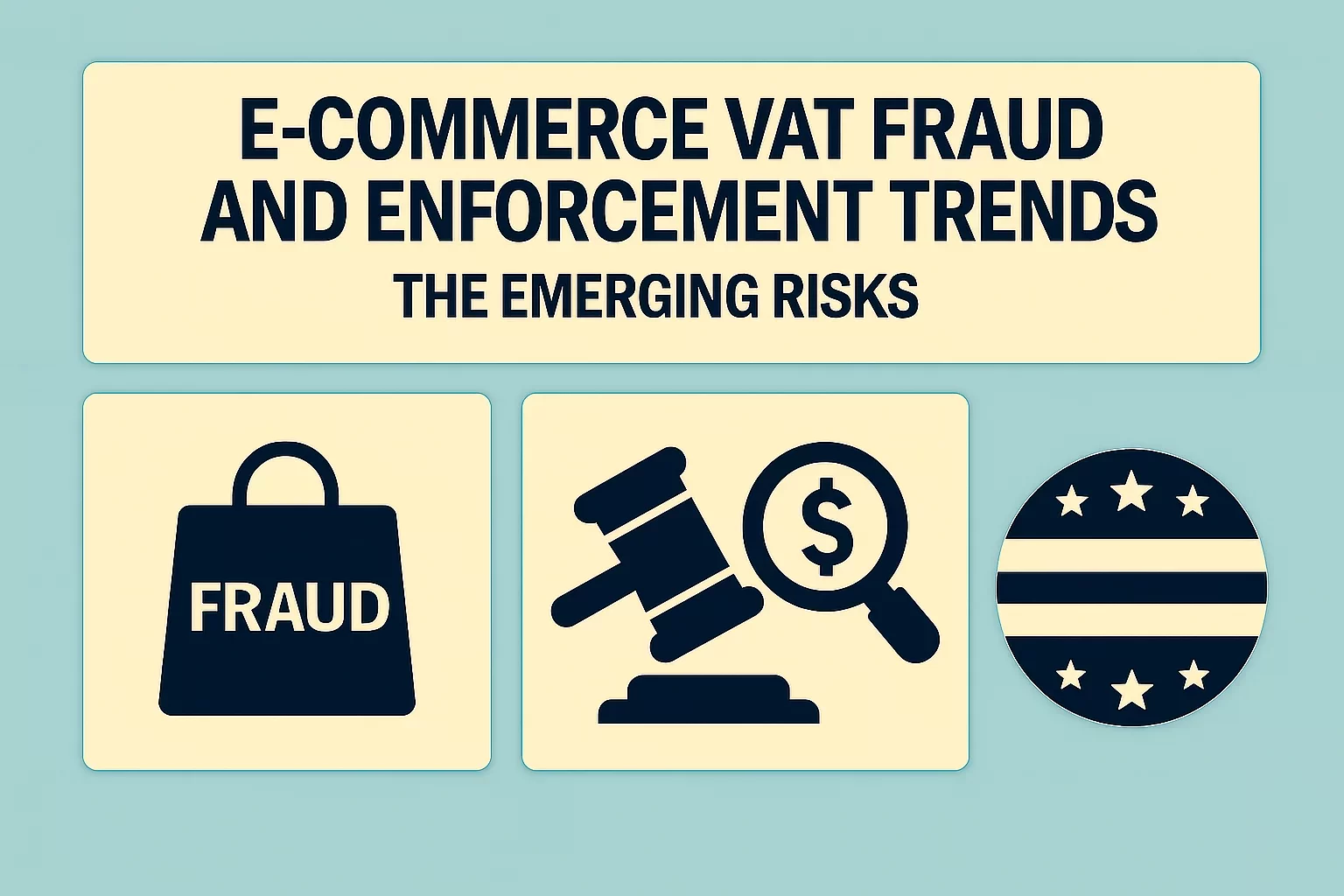Reporting in E-commerce: E-invoicing, Digital and Real-Time Reporting
Explore how e-invoicing and real-time reporting are transforming tax compliance for e-commerce businesses globally. Stay updated with key trends and regulations.
The digitalization of commerce and trade brought immense opportunities for global businesses, as well as for small online sellers, who now have access to a broader group of potential buyers. Over the past three decades, e-commerce has grown into a dominant retail and B2C channel, challenging and forcing Tax Authorities across the globe to strengthen indirect tax frameworks.
From defining VAT, GST, and sales tax registration thresholds, tax collection obligations, and simplification schemes like the EU’s OSS and IOSS, to developing and imposing new reporting requirements, such as e-invoicing, digital reporting, and real-time data transmission obligations. The transformation in how Tax Authorities deal with taxation in e-commerce is fundamentally changing the relationship between businesses and Tax Authorities, particularly for those operating across borders.
E-invoicing as the Foundation of Modern Tax Systems
Cross-border sales, remote service provision, and platform-mediated transactions, which are key elements of modern e-commerce, created reporting gaps and enforcement blind spots. To address these issues, governments had to find local and international solutions to track real-time sales data, detect fraud, and ensure timely tax collection, especially when dealing with non-resident sellers and digital platforms.
At the center of the reporting mechanisms is electronic invoicing, also known as e-invoicing. Unlike traditional PDF or paper invoices, e-invoices are structured digital files, typically in XML or UBL formats, that both businesses and Tax Authorities can automatically process. E-invoicing serves as a bridge between transaction execution and tax reporting, enabling authorities to access invoice data in real-time or shortly after issuance.
Typically, countries implement one of two main models: the post-audit model and the clearance model. In the post-audit models, taxable persons issue invoices and submit VAT returns later. Relevant documents are only reviewed by the Tax Authority during an audit. In contrast, the clearance model requires businesses to submit invoices to the Tax Authority for approval or data validation before sending them to the buyer. This model provides near real-time transaction visibility, significantly reducing opportunities for tax evasion.
In recent years, countries have moved away from post-audit models towards the clearance model. Some examples include Italy introducing the Sistema di Interscambio (SDI) e-invoicing processing system and Poland scheduling the implementation of the Krajowy System e-Faktur (KSeF) system, which will enable the convenient and quick issuance, receipt, and management of e-invoices in real-time.
Digital and Real-Time Reporting Mechanisms
Alongside e-invoicing, Tax Authorities are also implementing other digital and real-time reporting systems, requiring taxable persons to report specific sets of data, often requiring the submission of all transactional records, such as payment details, credit notes, and corrections.
For example, Spain introduced the Suministro Inmediato de Informacion (SII) system, requiring domestic and foreign businesses that are VAT-registered in Spain, with an annual turnover above EUR 6 million per year, companies registered in the Monthly Refund Register, the so-called REDEME scheme, and enterprises belonging to VAT groups in Spain to report VAT electronically on all transactions regardless of their value for B2B, B2G, and B2C domestic and intra-EU transactions sales and purchases. Taxable persons must submit the required data within four days of the invoice being issued, establishing a quasi-real-time reporting system.
Standard Audit File for Tax, or SAF-T, is a standardized reporting format for tax details and accounting data from the ERP, including VAT returns developed by the OECD. Countries that have implemented SAF-T requirements into their national legislation include EU countries such as Portugal, Poland, Lithuania, France, and Austria. Other countries that require SAF-T reporting are Angola and Norway, whereas Mozambique is considering the implementation, and Bulgaria and Ukraine have scheduled a phased implementation.
Other Reporting Requirements in the Digital Economy
As online marketplaces and digital platforms emerge as dominant figures in the modern global economy, governments and international bodies have developed other reporting requirements, particularly targeting platform-based transactions and digital services. Although not typically a requirement for indirect tax reporting, the introduction of the Digital Services Tax (DST) marks an essential mechanism for taxing large digital companies that operate across multiple countries.
France, Italy, Canada, and the UK have introduced DSTs to tax the revenue of large digital companies, such as Amazon, that operate in their markets but lack a physical presence. Despite the fact that the DST is distinct from VAT, it requires separate reporting and payment processes, resulting in parallel compliance tracks for affected companies.
Furthermore, online marketplaces and digital platforms, such as e-commerce platforms, now face additional reporting obligations. One such example is the EU’s DAC7 Directive, which requires platforms facilitating the sale of goods or services to report seller information and revenue to the Tax Authorities.
The EU's DAC7 Directive is based on the Model Rules for Reporting by Platform Operators concerning Sellers in the Sharing and Gig Economy (MRDP), published by the OECD in 2020, which has been adopted by Canada, the UK, and New Zealand. However, the EU's DAC 7 has a broader scope of reportable activities.
The presented platform reporting obligations focus on tax transparency rather than collection. However, they are closely linked with VAT frameworks by identifying non-compliant sellers and facilitating cross-border enforcement. For e-commerce platforms, compliance involves collecting, verifying, and securely transmitting data of online sellers, often with strict penalties for errors or omissions.
Key Lessons for Cross-Border E-commerce Sellers
For online sellers engaged in cross-border transactions, the shift from periodic VAT filings to real-time digital compliance represents a significant structural change in their business operations. Smaller taxable persons now also must ensure that every transaction, invoice, and adjustment is traceable, standardized, and reportable in the required format and timeframe.
On the other hand, e-commerce platforms must ensure that they collect precise data from online sellers and report it in a correct structure within defined deadlines. Moreover, with the marketplace facilitator and deemed supplier rules, online marketplaces now have to collect and remit indirect taxes on behalf of online sellers. All of this requires a strategic investment in tax technology and automation of compliance.
Generally, e-commerce sellers must ensure that their invoicing systems support local e-invoicing formats, evaluate whether their sales platforms can generate structured data, and whether they have real-time visibility into tax calculations.
Finally, as governments continue to expand their tax base and align and expand reporting rules, including e-invoicing, real-time VAT reporting, and DST, cross-border businesses must develop flexible systems that can adapt across jurisdictions. Part of the tax compliance strategy includes partnering with local tax companies, using compliant invoicing tools, and maintaining clear audit policies.
Conclusion
The solution to the growing issues relating to indirect tax collection in the e-commerce sector was to require marketplaces to collect and remit VAT on behalf of third-party sellers, that is, online marketplace sellers, introduce distance-selling thresholds, and simplify filings through schemes like the EU’s OSS. However, the need to establish a more standardized and even real-time reporting system remained.
In addition to developing a national e-invoicing system, governments worldwide started working on internationally recognized standards and models for tax reporting. E-invoicing and digital reporting are no longer optional, creating a multi-layered compliance system. In other words, VAT, GST, and sales tax reporting is no longer just a backend function, but a strategic matter in the global digital economy.
E-invoicing refers to invoices that are generated, exchanged, and processed in a structured digital format such as XML or UBL. Unlike traditional paper or PDF invoices, e-invoices can be automatically interpreted by Tax Authorities and business systems, enabling real-time or near-real-time compliance and validation.
In the post-audit model, businesses issue invoices and submit tax returns later, with documents reviewed only during audits. In the clearance model, invoices must be approved by the Tax Authority before being sent to the buyer, enabling real-time oversight and transaction validation.
The Standard Audit File for Tax (SAF-T) is a standardized format for submitting accounting and tax data developed by the OECD. Countries such as Portugal, Poland, France, Lithuania, Norway, and Angola utilize SAF-T to facilitate digital audits and enhance transparency in compliance.
Non-resident or foreign sellers who are VAT-registered in a specific country must often comply with local e-invoicing and real-time reporting requirements, particularly if they exceed revenue thresholds or engage in particular types of transactions.
DST is a separate tax from VAT, targeting large digital companies that generate revenue from online advertising, data use, or digital marketplaces in countries where they have no physical presence. DST requires separate reporting and payments, creating a parallel compliance track. Although it is not an indirect type of tax, it represents an important tax compliance matter for the largest e-commerce businesses.
Considering the current global trends toward standardized, digital, and real-time tax reporting systems, as well as the increasing adoption of these tools by governments to close tax gaps and harmonize cross-border compliance, it can be said that these reporting systems are becoming a global standard for indirect tax compliance.
Source: EY, European Council - Council of the European Union, Federal Inland Revenue Service of Nigeria, VATabout - UK - Reporting Rules For Digital Platforms, VATabout - EU Digital Reporting Requirements: Essential Guide for Non-Resident Taxpayers, VATabout - Digital Economy Taxation: VAT/GST on Digital Services vs. DST Explained, VATabout - The Role of Online Marketplaces in Indirect Tax Collection, VATabout - EU - DAC 7 Compliance and Digital Platforms


